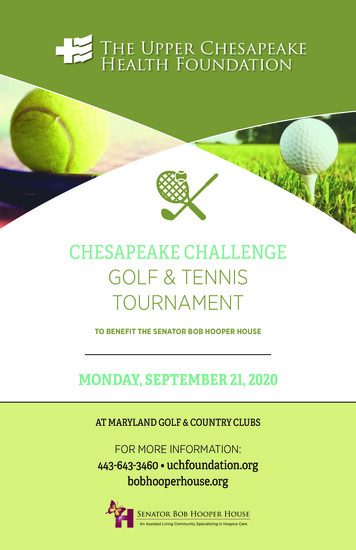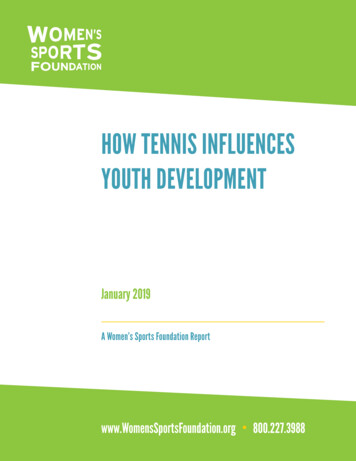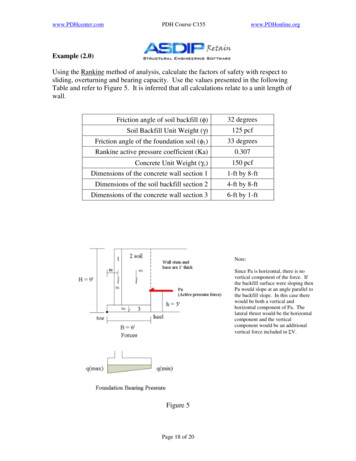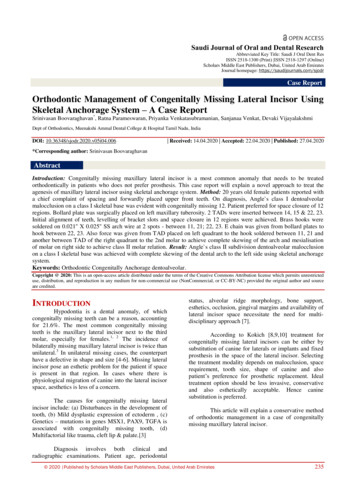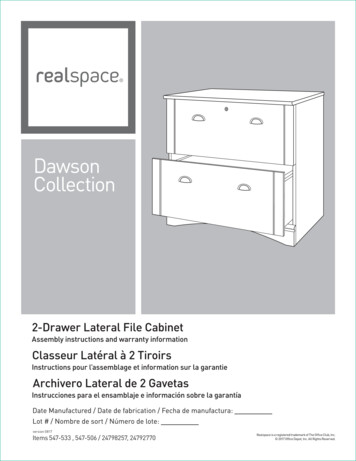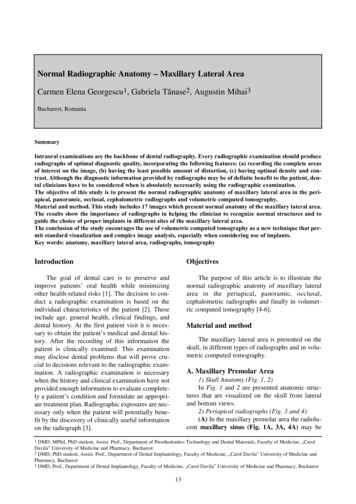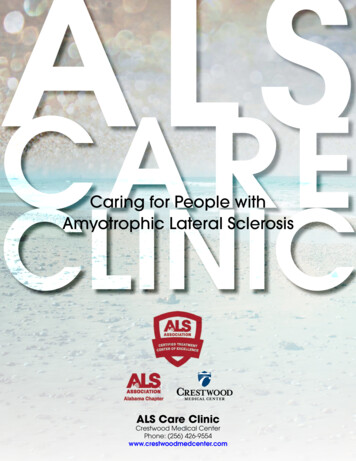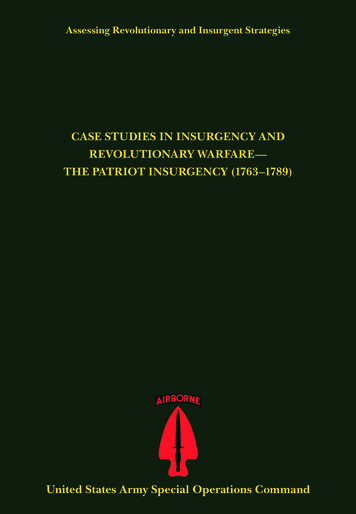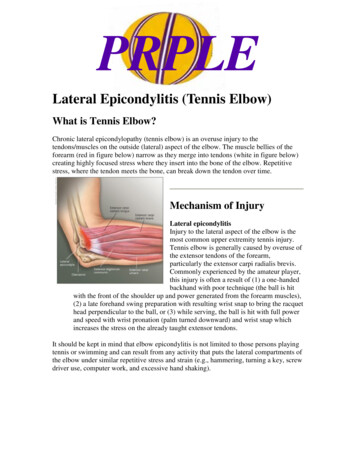
Transcription
PRPLELateral Epicondylitis (Tennis Elbow)What is Tennis Elbow?Chronic lateral epicondylopathy (tennis elbow) is an overuse injury to thetendons/muscles on the outside (lateral) aspect of the elbow. The muscle bellies of theforearm (red in figure below) narrow as they merge into tendons (white in figure below)creating highly focused stress where they insert into the bone of the elbow. Repetitivestress, where the tendon meets the bone, can break down the tendon over time.Mechanism of InjuryLateral epicondylitisInjury to the lateral aspect of the elbow is themost common upper extremity tennis injury.Tennis elbow is generally caused by overuse ofthe extensor tendons of the forearm,particularly the extensor carpi radialis brevis.Commonly experienced by the amateur player,this injury is often a result of (1) a one-handedbackhand with poor technique (the ball is hitwith the front of the shoulder up and power generated from the forearm muscles),(2) a late forehand swing preparation with resulting wrist snap to bring the racquethead perpendicular to the ball, or (3) while serving, the ball is hit with full powerand speed with wrist pronation (palm turned downward) and wrist snap whichincreases the stress on the already taught extensor tendons.It should be kept in mind that elbow epicondylitis is not limited to those persons playingtennis or swimming and can result from any activity that puts the lateral compartments ofthe elbow under similar repetitive stress and strain (e.g., hammering, turning a key, screwdriver use, computer work, and excessive hand shaking).
Signs and SymptomsGeneral difficulty holding onto, pinching, or gripping objectspain, stiffness, or insufficient elbow and hand movementforearm muscle tightnessinsufficient forearm functional strengthpoint tenderness at or near the insertion sites of the muscles of the lateral ormedial elbowSpecificLateral Epicondylitispainful resisted wrist extensionpainful resisted supination(rotating forearm as if to hold a bowl of soup in your hand)palpation tenderness of the lateral epicondyleRehabilitation - What You Can ExpectEpicondylitis is a common and often lingering pathologic condition. It is critical,therefore, that you progress your rehabilitation only when you experience minimal or nopain. For more on when and how to progress, see below.As a general guideline, the more chronic or longer you have experienced the condition,the longer the recovery time is to be expected (up to 8 weeks).Rehabilitation - What should I do, when should I do it,and how?Epicondylitis often becomes a chronic problem if not cared for properly. For this reason,it must be stressed that the rehabilitation process should not be progressed until youexperience little or no pain at the level you are performing. Regaining full strength andflexibility is critical before returning to your previous level of sports activity.In general, the rehabilitation process can be divided into three phases:
PHASE 1Goals: decrease inflammation and pain, promote tissue healing, and retard muscleatrophy. During the acute stage of your injury, whether the medial or lateralelbow is affected, follow the RICE principle: Rest - this means avoiding further overuse not absence of activity. Youshould maintain as high an activity level as possible while avoidingactivities that aggravate the injury. Absolute rest should be avoided as itencourages muscle atrophy, deconditions tissue, and decreases bloodsupply to the area, all of which is detrimental to the healing process. Painis the best guide to determine the appropriate type and level of activity.Ice - is recommended as long as inflammation is present. This may meanthroughout the entire rehabilitation process and return to sports. Icedecreases the inflammatory process slows local metabolism and helpsrelieve pain and muscle spasm.Compress and Elevate if appropriate to assist venous return and minimizeswelling.PHASE 2Goals: Improve flexibility, increase strength and endurance, increase functionalactivities and return to function.Stretching weeks 0- 2Gentle stretching exercises including wrist flexion and pronation. The elbowshould be extended and not flexed to increase the amount of stretch as required.These stretches should be held for 20-30 seconds and repeated 5-10 times, at leasttwice a day. Vigorous stretching should be avoided - do not stretch to the point ofpain that reproduces your symptoms.
Strengthening weeks 2-8 (6 week total)With the elbow bent and the wrist supported perform the following exercises:1. Wrist Extensors. Place 1 lb. weight in hand with palm facing downward;support forearm at the edge of a table or on your knee so that only yourhand can move. Using your free hand, help raise your weighted hand tothe starting position and slowly let weight pull you down to the flexedposition (eccentric contraction). 3 sets of 10, three times daily.
2. Forearm Supinators. Place 1 lb. weight in hand, use your other hand tohelp rotate the weighted hand to the starting position and then slowly letyour wrist fall into the palm down position. 3 sets of 10, three times daily.After exercising, massage across the area of tenderness with an ice cube for about5 minutes. You might also try filling a paper cup half-full with water and freeze;peel back a portion of the paper cup to expose the ice.PHASE 3Goals: Improve muscular strength and endurance, maintain and improveflexibility, and gradually return to prior level of sport or high level activity.Continue the stretching and strengthening exercises emphasizing the eccentriccontractions of wrist flexion and extension. In this regard, since the eccentriccontractions are movements with gravity, do not let the weight drop too quickly;lower the weight in a controlled fashion.When your symptoms are resolved and have regained full range of motion andstrength, you may gradually increase your level of activity.
The Scoop on BracingLateral counter-force bracing is believedto reduce the magnitude of musclecontraction which in turn reduces thedegree of muscle tension in the region ofmuscular attachment. The counter-forcebrace is essentially an inelastic cuff that isworn around the proximal (near) forearm(against the forearm extensors for lateralepicondylitis).In theory, the brace constrains full muscle expansion when the muscle contracts,diminishes muscle activity, and therefore the force generated by the muscle. An analogyis the fret on a guitar; when you exert pressure on a different fret along the neck of theguitar, it changes and reduces the tension on the guitar string above where the pressure isexerted.The counter-force brace can be worn beginning in Phase 2 of your rehabilitation program.However, adhere to the following caution: do not become dependent on the counter-forcebrace and gradually wean yourself off its use during Phase 3. Counter-force bracing is asupplement to, not a replacement.Protocol adopted from: medial-epicondylitis
PRPLE. Lateral Epicondylitis (Tennis Elbow) What is Tennis Elbow? Chronic lateral epicondylopathy (tennis elbow) is an overuse injury to the tend
